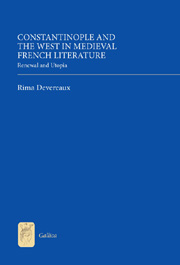Book contents
- Frontmatter
- Contents
- List of illustrations
- Dedication
- Acknowledgements
- List of abbreviations
- Note to the reader
- Introduction
- Part I Renewal and Utopia: The Terms of the Debate
- Part II Constantinople Desired
- Part III The Renovatio of the West
- 5 Translatio Embodied? Renewal, Truth and the Status of Constantinople in Thirteenth-Century Didactic Texts
- 6 Renovatio as Commemoration: Civic Loyalty and the Latin Empire of Constantinople in Venetian Historiography
- Conclusion
- Appendix 1 Original Latin Quotations
- Appendix 2 References to Constantinople in Other Epics and Romances
- Appendix 3 Outline of Events in the History of East–West Relations from the Second Crusade to the Palaeologan Reconquest
- Bibliography
- Index
- Already Published
6 - Renovatio as Commemoration: Civic Loyalty and the Latin Empire of Constantinople in Venetian Historiography
from Part III - The Renovatio of the West
Published online by Cambridge University Press: 05 February 2013
- Frontmatter
- Contents
- List of illustrations
- Dedication
- Acknowledgements
- List of abbreviations
- Note to the reader
- Introduction
- Part I Renewal and Utopia: The Terms of the Debate
- Part II Constantinople Desired
- Part III The Renovatio of the West
- 5 Translatio Embodied? Renewal, Truth and the Status of Constantinople in Thirteenth-Century Didactic Texts
- 6 Renovatio as Commemoration: Civic Loyalty and the Latin Empire of Constantinople in Venetian Historiography
- Conclusion
- Appendix 1 Original Latin Quotations
- Appendix 2 References to Constantinople in Other Epics and Romances
- Appendix 3 Outline of Events in the History of East–West Relations from the Second Crusade to the Palaeologan Reconquest
- Bibliography
- Index
- Already Published
Summary
We have just been looking at the difficulty of discerning truth and the problem that this poses for the location of renewal in the West, and have seen that the journey to Constantinople may provide a potential solution to this problem. Here we look at how venetian historiography commemorated recent events concerning venice, and especially its relationship with Byzantium. The texts' celebration of civic loyalty as a model for imitation contributes to their elaboration of the theme of Western renewal.
The association between venice and Byzantium stretches back for centuries before the thirteenth, when the earliest text with which I will be dealing was produced. Originally a Byzantine province, and then under Byzantine jurisdiction, in the tenth century venice rose to be an independent sovereign state that continued to maintain close ties with the Byzantine empire. Over the years between 992 and 1198 venice obtained from Byzantium a number of trading privileges, in the form of chrysobulls or imperial diplomas acting as commercial treaties, which regulated trade and the traffic of Venetian merchant ships. In 1082 the venetians gained their own quarter in Constantinople, and established a permanent colony of traders there, with certain buildings, a church and three landing stages officially designated as Venetian property. The doge received the hereditary title of protosebastos with an attached pension. Other italian city-republics, including Genoa, entered into trading agreements with Byzantium in the course of the twelfth century.
- Type
- Chapter
- Information
- Constantinople and the West in Medieval French LiteratureRenewal and Utopia, pp. 157 - 182Publisher: Boydell & BrewerPrint publication year: 2012



